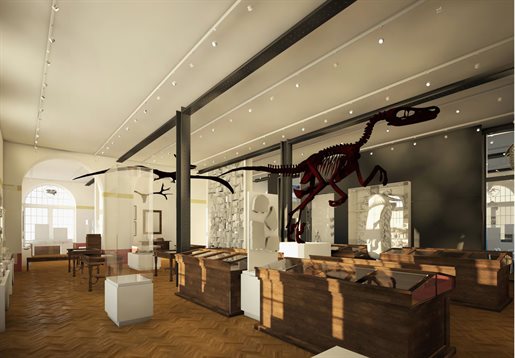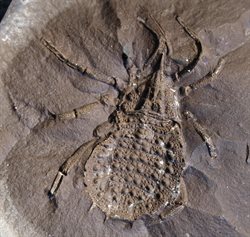Early next year, visitors to the University of Birmingham’s 100-year-old Edgbaston campus will be able to see more than four billion years of history brought to life as the University’s very own geological museum reopens its doors following a £2.5 million refurbishment. Kara Griffiths reports.
The Lapworth Museum of Geology will throw open its doors to visitors again early in 2016 when they will enjoy a state-of-the-art museum experience with light and airy spaces enhancing the setting of the displays, and a new range of innovative new interactive and tactile experiences. With the museum housed in a wing of the University’s Edwardian Aston Webb building, the redevelopment currently underway will also make full use of the original features and display cabinets of the museum, which dates back to 1880, making it one of the oldest specialist geological museums in the UK.

When the museum reopens, exhibits which have been hidden from public sight for many years will go on display, bringing new audiences to some of the quarter of a million specimens of national and international importance which the museum collection comprises. The mineral and gem collections alone contain more than 20,000 examples of worldwide provenance, many of them with stunning and rare crystal forms. This includes Matthew Boulton’s historic specimens, currently on loan to the Lapworth from Birmingham Museum and Art Gallery and Birmingham Museums Trust. This collection features alongside that of William Murdoch, an engineer, inventor and associate of James Watt and Boulton, bringing together these two early mineral collections from famous sons of Birmingham and key players in the Industrial Revolution.
The museum will be far more than a series of artefacts behind glass, as it will reopen with the intention of piquing visitors’ curiosity about the world in which they live at every turn. Some of their biggest questions will be answered as they explore the museum’s four themes. Starting with Evolution of Life, the formation of fossils will be explained whilst researchers will describe what puzzles they need to unlock to understand the fossil record. The second theme, Active Earth, will take people on a journey to the Earth’s core and back, exploring the shifting plates which make up our world, and developing an understanding of not only why and how they move – with catastrophic effect on occasion – but also, how scientists have come to understand and detect these events – and how they may be able to predict them with increasing accuracy in the future.
 The geological importance of the locality will never be far from the minds of visitors to the museum, as the extensive fossil collections will help people to understand the region’s dramatic transformation from tropical seas and coal forests to deserts and ice sheets over the last 450 million years. There are even remains of woolly mammoths to really stir the imagination into considering life during the Ice Age. But the exhibits are about far more than looking back to the past as researchers from Birmingham use these collections to explain changes in our planet from sea level to climate change and continental drift – issues which affect our lives on this planet today and will continue to do so into the future. Mass extinctions and dramatic evolutionary changes can be tracked through studying the collections which make up the museum.
The geological importance of the locality will never be far from the minds of visitors to the museum, as the extensive fossil collections will help people to understand the region’s dramatic transformation from tropical seas and coal forests to deserts and ice sheets over the last 450 million years. There are even remains of woolly mammoths to really stir the imagination into considering life during the Ice Age. But the exhibits are about far more than looking back to the past as researchers from Birmingham use these collections to explain changes in our planet from sea level to climate change and continental drift – issues which affect our lives on this planet today and will continue to do so into the future. Mass extinctions and dramatic evolutionary changes can be tracked through studying the collections which make up the museum.
Visitors will have ample opportunity to discover the exquisite beauty of the gems and minerals housed in Birmingham and they will also be encouraged to interact with them, exploring how the stunning pieces form initially, how they are discovered and how they are then used in local industry.
The Mineral Wealth theme will look at - and answer – the questions of why the West Midlands region and its natural resources lent themselves to being the birthplace of the Industrial Revolution, something which has shaped our region up until the current day.
But the museum will also have an important role to play in educating its guests about the research its collections have assisted, and the important scientific discoveries made as a result of the collections so painstakingly put together by Boulton and many others – not least the man who gave his name to the museum, geological pioneer Charles Lapworth, as well as the top secret work by Fred Shotton carried out in advance of the D-Day landings. Other historically important material includes specimens donated by Sir Raymond Priestley and collected whilst serving as the geologist on Captain Scott’s ill-fated Antarctic expedition.
Dr Richard Butler, Academic Keeper of the Lapworth Museum says: “The Lapworth Museum collections have inspired generations of research, and are used today by researchers ranging from our own undergraduate students to internationally-recognised palaeontologists, geologists and historians of science.
“New technologies, such as CT scanning and photogrammetry, are providing us with exciting new tools to reveal the secrets of ancient life.”
This work will not stand still – and as new technologies are discovered and new methods pioneered, researchers will continue to revisit these most important collections to find out even more about our world, its past and crucially, its future.